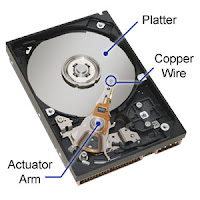
Curiosity, it is said, killed the cat. Many people are curious as to the inner workings of their hard drives and to date, no people have died due to this curiosity, although quite a few hard drives have suffered fatal injuries. The implications of this is put into perspective when you consider that the best way to learn how a hard drive works and therefore eliminate your fear of damaging said hard drive is to take it apart and look inside. Then, consider that opening a hard drive ruins it and it is not fixable once you have opened it. Therefore, if you must explore the inner workings of your hard drive in order to feel as one with your computer, choose to open a defunct hard drive or purchase one from a second hand computer store. Do not attempt to take apart the hard drive you intend to use on your computer as it will not be able to work after the deed is done.
Hard drives are actually quite small and are contained in sealed aluminum boxes. On one side, there is a panel of electronics that detaches from the rest of the hard drive. These electronics control the read and write functions as well as the motor that spins the platters, which we will get into in a bit. It is the job of the electronics to turn the magnetic domains into bytes for reading and to return those bytes into magnetic domains for writing.
If you look under the board of electronics, you'll find the connections for the motor and a vent hole. The purpose of the vent hole is to equalize pressure from internal and external air sources to keep things running smoothly and to release heat that is built up during the running of the hard drive.
You will also find the mirror like platters, which spin at speeds up to 7,200 rpm when the drive is operating and the arm, which holds the read and write heads. Most computers, with the intent of increasing the amount of data the drive can store, have more than one platter and more than one head. Usually, the number of platters is doubled in the number of read and write heads held by the arm. In other words, if a computer has three platters, then it will most likely have six read and write heads, or arms.
As can be expected, the arm must move at an extremely rapid pace and be exactly precise in its movement. For this reason, the motor for the arm is constructed using a high speed linear motor. Not all computers use the same motor, though, for this purpose. Some use voice coil, which is a technique commonly seen and used to move the cone of speakers in a stereo.
Data is stored on the surface of each platter. The pattern looks similar to a pie as a computer uses sectors and tracks to store information. Tracks have a concentric shape while sectors look like pie wedges. Sectors are also finite in the number of bytes each can store, which is typically either 256 or 512 bytes and are therefore often stored in clusters on the platter.
Now that you know the inner components of your computer's hard drive, perhaps your curiosity will be sated, thus saving your hard drive from any harm. Each component of the hard drive works in tandem with every other part to deliver a high performing and speedy work environment for you, the computer's user. While fragile in nature considering the response of a hard drive to being dismantled for observation, most users can expect a hard drive to last for many years before needing to be replaced. The hard drive is not a mysterious part of your computer, but rather the central intelligence of your computer and its capabilities based on what you tell it to store for you.

0 comments:
Post a Comment